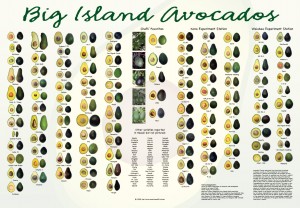Hawai’i’s Many Avocados | How Did They Get Here?
Hawai’i hasn’t always been the capital of amazingly delicious avocados! In fact, unless you live in Hawai’i, or have visited the islands, many people don’t even know about Hawai’i’s many, and many new emerging avocado (persea americana) varieties. The world beyond Hawai’i (and, some mass-market grocery stores in Hawai’i), only seem to be familiar with a smaller and blander version of the fruit; the mass produced Central American, South American, Mexican, and California grown Calavo (NASDAQ Calavo Growers, Inc) avocados.
Within the beautiful Hawaiian Islands, there are now approximately over 200 avocado varieties. How did Hawai’i get so many types avocados?
For over 200 years immigrants have been visiting, and staying on the Hawaiian Islands; explorers, traders, colonists, missionaries, whale poachers, and a host of plantation workers from all around the world. Our tasty avocado fruits came by way of ships that traveled to Hawai’i from Mexico, Central and South America, Spain, Portugal, Brazil and Puerto Rico. Seeds of the varying avocado fruits were planted, shared, grafted and grown in home gardens and farms. Local farmers picked up on the value of the avocado fruit and trees, and many of Hawai’i’s first avocado varieties were in fact cultivated by Japanese coffee farmers on Hawai’i’s Big Island. Naming these buttery fruits like they were family, a handful of Hawai’i’s avocado varieties have the famous surnames to prove it; Ohata, Yamagata, and Nishikawa.
Within Hawai’i’s over 200 avocado varieties, we have all three of the main physical classifications of avocado families; thin-skinned (Mexican Linda’s), smooth-skinned with large fruit and smaller seeds (Caribbean Malama’s), and the hard and bumpy-skinned (Guatemalan Hass aka Hawaiian Hass). The Kona area of the Big Island of Hawai’i has historically been the premier area for avocado growing throughout Hawai’i. Of course, Hawaiian avocado varieties are also found throughout the State of Hawai’i; Big Island, Maui, Oahu, Kaua’i, and the outer islands. But, farms that are focused on the cultivation of avocados are mainly in the Kona area, and have been long time reared from older farms along the ‘Kona Coffee Belt.’
Unfortunately, or fortunately for Hawai’i depending on how you view it, information and historical research about the cultivation of the 200+ varieties of avocados in Hawai’i is rare knowledge. Perhaps because it wasn’t followed closely from conception, or perhaps because it wasn’t seen as important or financially lucrative at the time. Taken from a University of Hawai’i circular written by W.T. Pope in 1933, “There are at a present time hundreds of different seedling avocado trees in Hawai’i. No two of these trees bear fruit exactly alike. It is very difficult to establish a dependable market for avocados which are all so different from another. In California, the avocado producers have organized and are attempting to discard all but a few of the best varieties as it is realized that the market demands a reasonable uniform, dependable product. Hawai’i should do the same with her tree fruits.” Well, that’s an interesting thought! Perhaps Hawai’i’s “producers” were more focused on the financial stability of Hawai’i’s agricultural business coming from sugarcane and tropical fruit plantations at this time. And, maybe this form of thought noted by W.T. Pope was a sign of the times, and a reason why we still have so many delectable varieties of avocado in Hawai’i today.
Hawai’i’s Department of Agriculture and the University of Hawai’i’s College of Agriculture and Human Resources (est. 1907) are the main researchers of Hawai’i’s avocado agricultural research, although there are also a handful field experts. One that particularly shines is Ken Love of the Big Island. For over 32 years, he has been very active in providing research of his findings to the public, universities, by way of offering detailed diagrams and research documents pertaining to the history and cultivation of Big Island avocados. More info about Ken Love can be found here: www.hawaiifruit.net
There has been much speculation and conversation regarding Hawai’i’s avocados, if they could be a cash crop, if they should be exported, etc. What is your opinion? Better yet, what is your favorite avocado from Hawai’i? Please let us know your thoughts in the comment section below, and feel free to attach a picture of your favorite Hawai’i avocado and its name… Mahalo for reading!
Online & Print Sources:
- Hollier, Dennis. “The Mystery of the Hawaiian Avocado.” (Interview w/ Ken Love) Hana Hou Magazine. Oct/Nov 2008. hanahou.com/pages/Magazine.asp?Action=DrawArticle&ArticleID=728&MagazineID=45
- Pope, W.T. Grafting Tropical Fruit Trees In Hawaii. (Circular #6) Honolulu, Hawaii. University of Hawaii & U.S. Dept. Of Agriculture, 1933. Print
- Whistler, W. Arthur. Plants of the Canoe People. Kalaheo, Kaua’i, Hawaii. National Tropical Botanical Garden, 2009. Print.
















